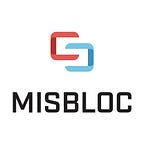Blockchain Vocabulary #2
MISBLOC (Medical Information Service with Blockchain) is a medical service ecosystem which is based on blockchain technology. MISBLOC offers a sustainable and efficient medical service ecosystem by providing reliable medical information to patients, medical institutions, and public institutions in the Big Data era.
Welcome to MISBLOC!
In today’s article, we’re again going to go over some blockchain vocabulary. We covered the first part in August and we’ve returned for part two today! We know that entering the blockchain space can be overwhelming sometimes, filled with abbreviations and terms you’ve never heard of. Here, we’ll give a simple definition to some of the most common blockchain terminologies! Enjoy!
Blockchain Terminology
Mainnet
A mainnet is an independent blockchain that has been fully developed and deployed so that cryptocurrency transactions can be recorded. Bitcoin and Ethereum do not have a centralized database. Therefore, they use a distributed data storage structure called a node, which prevents forgery and alteration of the blockchain. In the blockchain field, an organization with its own nodes is described as, “having a mainnet.”
Mainnets can have their own dApps, blockchain services that run on mainnets. Not only can digital currency be created on the blockchain network system, but dApps can also be established to help form an independent ecosystem.
Testnet
A testnet is software that tests any changes before applying them to the actual blockchain network. It is a temporary test created by making a blockchain with the same conditions as the mainnet. It can be thought of as a kind of beta service through which developers can verify the stability of new blockchain software and wallets. Finally, they can release it as a mainnet on an independent blockchain.
Testnet is an indispensable process in the smart contract development stage. Since it’s the same environment as the mainnet, you can see in real-time if the project actually does what you want. Even now, many blockchain projects generate tokens, run projects, and stabilize them on the testnet. If you convert the testnet into a mainnet after this process, another ecosystem will be created.
Token Swap
A token swap can refer to the exchange of tokens previously held by token holders for new tokens with improved functionality, also called token migration. You can think of it as updating your tokens. In other words, the balance of the token is transferred to the wallet of a new compatible project. When the token swap is complete, it means that the tokens have been moved safely to the new blockchain.
Most tokens generated on a blockchain cannot be modified once issued. Therefore, when a new function is added to a token in the future, a new token needs to be issued. This is called a token swap. Recently, the frequency of token swaps has been increasing as the functions of coins continue to improve.
On-chain/Off-chain
A blockchain is a network that connects data block by block. It inevitably takes a long time to record the data because you have to validate every transaction that occurs on each block. “On-chain” literally refers to the act of recording the data on the blockchain in this way.
Therefore, it makes sense that “off-chain” is not a method of recording data directly on the blockchain, but instead of recording transaction details off the blockchain. Because there is no need for consensus or verification, many experts see this as a way to solve the scalability problem that on-chain transactions cannot solve. However, since off-chain is not recorded on the blockchain, there is a possibility of hacking, data forgery, and alteration.
Token vs. Coin
Tokens refer to cryptocurrencies issued by dApps. Coins refer to cryptocurrencies issued on platforms such as Ethereum and Quantum, which have their own protocols and mainnet. Keep in mind that, sometimes, tokens can function as coins if the dApp becomes popular enough.
ICO
ICO stands for Initial Coin Offering. Like an Initial Public Offering (IPO), where traditional companies publically list their stocks, in an ICO, blockchain startups issue their cryptocurrency. Then, they open a certain number of tokens to the market and sell them to interested people in order to raise funds.
ICOs are a way to raise funds as quickly as possible without an audit process. From an investor’s point of view, participating in an ICO lets them earn crypto tokens and take ownership of their shares. Later, when the currency is listed on an exchange, they can make a profit by trading.
However, since anyone can easily do them, ICOs for projects without substance have emerged. Due to the rampant abuse and fraud that has occurred, participation around the world has decreased.
Wow! We covered a lot of very complicated concepts today. Hopefully, our explanations were sufficient for you and you now have the confidence to discuss blockchain technology with friends and family. It’s important to be aware of any developments in this field if you want to be a savvy investor. Thanks for checking in, see you next time!
